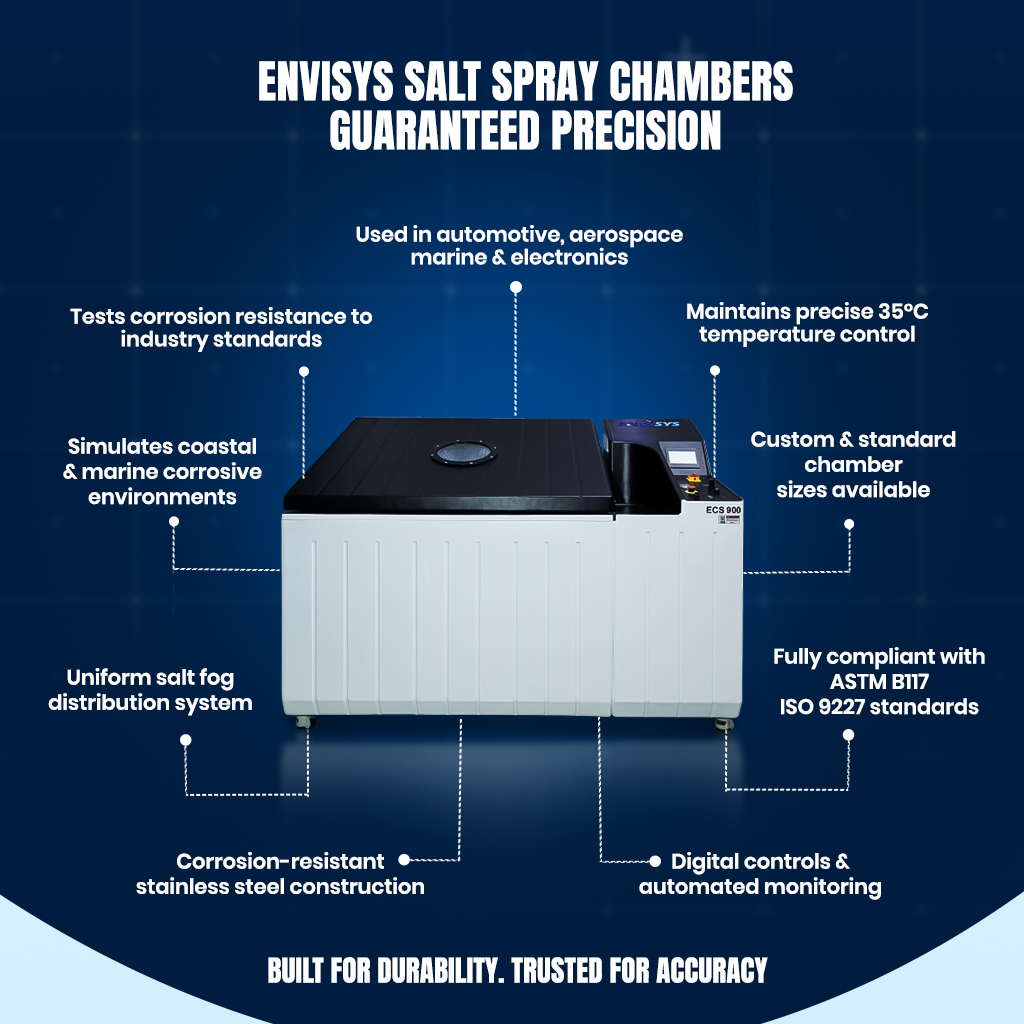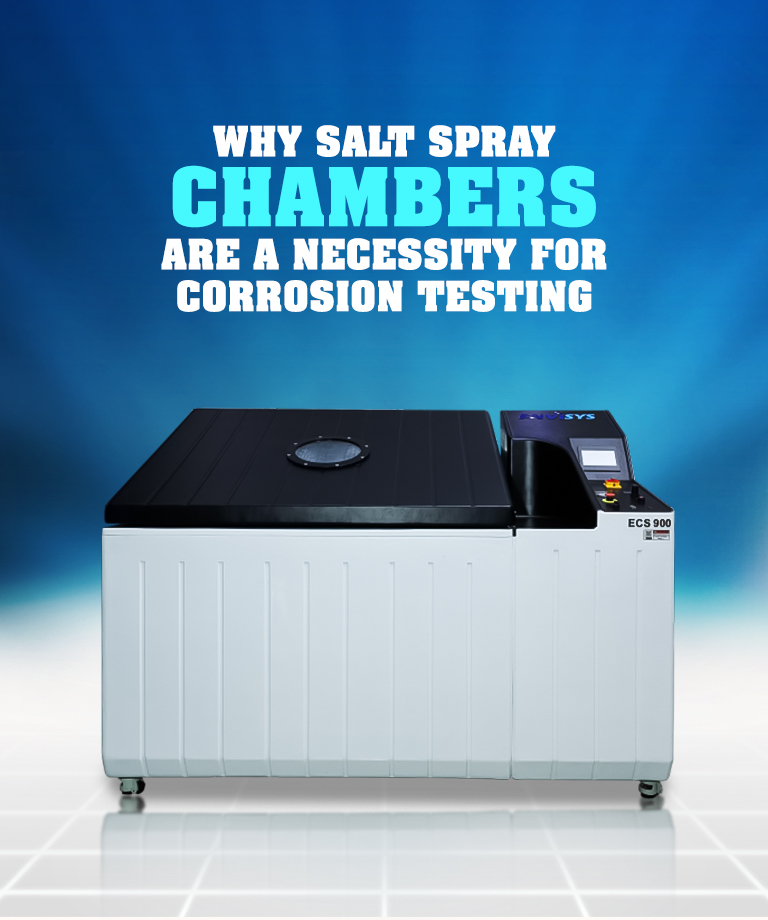Corrosion is the quiet destroyer of industrial machinery, infrastructure, and consumer goods. It’s a billion-dollar pain for industries every year in replacements, repairs, and untimely failures. However, most corrosion damage is completely preventable, if you detect the weakness soon enough. That’s exactly why salt spray chambers have become must-have equipment in quality control labs globally.
What Is a Salt Spray Chamber?
A salt spray chamber, or salt fog chamber, is specialty test equipment used to test the corrosion resistance of materials and coatings. It develops a highly controlled, accelerated corrosive environment by applying a fine aerosolized saltwater solution spray to test specimens, mimicking years of coastal or marine exposure in a matter of days or weeks.
The principle is simple: salt causes corrosion. By subjecting materials to a high concentration of salt fog in a controlled temperature and humidity environment, manufacturers can anticipate how their products will fare in actual corrosive environments. What could take years to see in the field can be replicated in a test chamber in hours.
Contemporary salt spray chambers have several major components that work, a closed testing chamber made of corrosion-resistant materials, a reservoir for the solution, a highly advanced system for atomizing the fine fog, accurate temperature control, and collection systems for the used solution. These components provide a repeatable, standardized test environment that generates consistent, comparable results.

How Salt Spray Chambers Work
The process of testing starts with the solution of saltwater, usually a 5% sodium chloride solution that is similar to seawater. This solution is atomized into a cloud of fine droplets by compressed air and thus forms fog particles that uniformly deposit on test specimens within the chamber.
Temperature is an important factor in the process. Most routine tests are conducted at 35°C, though specifications depend on the test standard being used. The chamber ensures this temperature with accuracy since minor changes can profoundly affect corrosion rates and test integrity.
Test duration is solely determined by the material under test and the specification under which testing is being conducted. Some tests are 24 hours, others weeks. During the course of the test, the specimens are continually immersed in salt fog, preying on any weakness in coatings, finishes, or underlying material.
Once testing is over, samples are withdrawn, cleaned, and inspected. For rust development, coating deterioration, blistering, and depth of penetration, inspectors earch. These observations yield measurable information regarding corrosion resistance that guides material choice, coating refinement, and quality control.
Such as with any measurement instrument, salt spray chambers must be properly maintained to provide consistent, repeatable results. Failure to do so doesn’t only create invalidity for tests it can also cause early equipment failure and expensive downtime.
The interior of the chamber requires maintenance after every test cycle. Salt precipitates build up on internal components and walls as well as spray nozzles. Left untreated, the precipitates change spray patterns, influence humidity distribution, and ultimately destroy the chamber. Cleaning with deionized water takes off salt residue and avoids precipitation buildup.
Spray nozzles need special attention. These tiny parts form the even fog pattern that guarantees uniform test conditions. Defective or worn-out nozzles create uneven spray patterns that compromise test outcomes. Ongoing inspection and replacement of nozzles ensures testing integrity.
Solution reservoir and delivery system require periodic flushing to avoid salt crystallization in lines and valves. Regular calibration of temperature sensors, pressure regulator checks to ensure proper fog generation, and door seals should be intact to avoid fog leakage.
Companies like Envisys Technologies emphasize preventive maintenance as integral to testing reliability. Their chambers are designed with accessibility in mind, making routine maintenance straightforward rather than burdensome. This design philosophy recognizes that a well-maintained chamber provides decades of reliable service.
Critical Applications Across Industries
Salt spray testing has become standard practice across an impressive range of industries, each with distinct concerns but a shared need to understand corrosion resistance.
The automotive industry is dependent almost entirely upon salt spray chambers. Cars are exposed to road salt during winter weather, marine humidity, and industrial emissions. Each body panel to fastener is subject to salt spray testing to guarantee vehicles retain their appearance and structural integrity for the duration of service life.
Aerospace uses require even higher standards. Aircraft fly through water-filled clouds, expose themselves to salt spray at seashore airports, and experience wide temperature fluctuations. Aerospace corrosion is not cosmetic; it is a safety consideration. Salt spray testing ensures that each component remains unaffected by these extremes of conditions.
The marine market has clear requirements. Vessels, offshore structures, and coastal facilities are subjected to continuous exposure to salt. Salt spray chambers assist engineers in choosing the proper materials and protective coatings for given marine conditions. The distinction between a twenty-year-versus-five-year coating system usually becomes evident through accelerated testing well before deployment in the field.
Electronics companies test product enclosures and connectors, construction hardware is tested, even the fasteners that are used to hold solar panels together require corrosion resistance certification, a corroded mounting system can cause panel failure irrespective of the performance of the panel itself.
The Strategic Value of Salt Spray Testing
Spending money on good corrosion testing pays dividends that reach far beyond short-term quality assurance. Spending hundreds of dollars on the time and equipment to do a salt spray test could be compared to warranty claims, field replacements, and reputation damage due to corrosion failures; the return on investment is clear quickly.
Testing also stimulates innovation. When engineers can observe precisely where and how corrosion starts, they can redesign products, optimize coating procedures, or choose improved materials. This self-reinforcing improvement process creates truly better products.
Salt spray chambers are more than test equipment; they’re risk management devices safeguarding investments, confirming design choices, and giving assurance necessary to back long-term warranties. In markets where corrosion is a constant danger, they’re critical infrastructure for creating long-lasting products.

